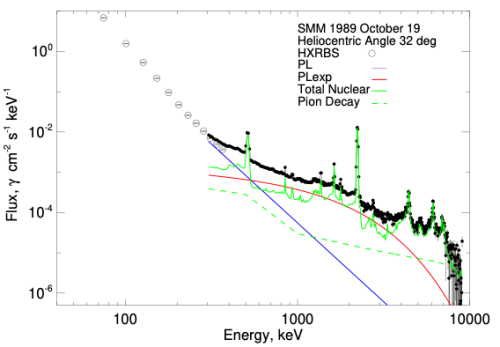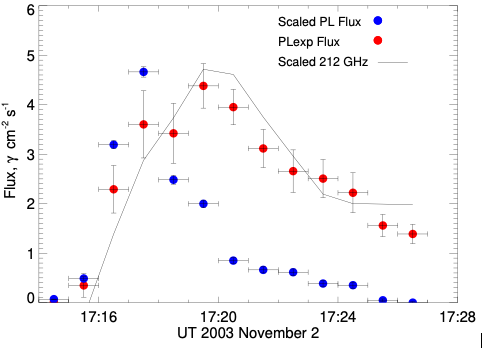Solar Gamma-Ray Evidence for a Distinct Population of MeV Flare-Accelerated Electrons
| Nugget | |
|---|---|
| Number: | 488 |
| 1st Author: | Gerry Share |
| 2nd Author: | |
| Published: | 10 February 2025 |
| Next Nugget: | Flare gamma-ray imaging |
| Previous Nugget: | From Chromospheric Evaporation to Coronal Rain: An Investigation of the Mass and Energy Cycle of a Flare |
Introduction
Solar flares involve the acceleration of particles to very high energies. Several different mechanisms are at work, and the particles play important roles not only in flare physics, but also in space weather and therefore in human affairs. Particles of all kinds are acccelerated, and we even observe MeV-energy neutral atoms. Remote sensing of accelerated ions is much harder than for electrons, which couple well to many observables. Here we discuss the solar gamma-ray emissions uniquely capable of tracking relativistic electrons via their direct bremsstrahlung radiation.
Gamma rays
Improved understanding of the cross sections for producing nuclear gamma-ray lines has allowed us to better characterize the emission from > 0.3 MeV electrons. We have studied gamma-ray emission in 25 large flares observed from 1981 to 2017 and find that there are two distinct electron populations which contribute to the gamma-ray continuum (Ref. [1]). These populations are revealed in the combined data from the Solar Maximum Mission (SMM) for the flare SOL1989-10-19 as plotted in Figure 1. We find a power-law component (PL, blue) fit to the >0.3 MeV GRS data; this is an extension of the well-studied hard X-ray continuum at a few 10s of keV. Along with the nuclear lines and continua our fits require a much harder component (red) that we represent spectroscopically as a flat power law times an exponential (PLexp).

In an extension of the RHESSI imaging spectroscopic study of flare SOL2005-01-20 flare (Ref. [2]) we show in Figure 2 that the PL and nuclear emissions originate from the footpoints, while the PLexp emission comes from the corona.

The distinct nature of these two components is also supported by their different time histories in most flares. For example, although both emissions start at the same time in SOL2003-11-02, observed by RHESSI and plotted in Figure 3, the PLexp flux peaks later and remains at a higher intensity longer than the PL flux. In addition, while the significant variations of the PL index and flux with heliocentric angle reveal the radiating electrons' anisotropy, such variations are not observed in the PLexp component with 99.7% confidence.
Mechanisms
The flat spectrum of the PLexp component can be produced by thin-target bremsstrahlung from electrons with a spectrum that peaks between 3 and 5 MeV and by inverse Compton scattering of soft X-rays by a hard spectrum of electrons reaching 10 to 20 MeV, or by a combination of the two. Ref. [3] discusses how such flat electron spectra can be produced in stochastic acceleration models for trapped electrons near the loop top. Such high-energy electrons can produce 10's of GHZ microwave and submillimeter radiation in coronal magnetic fields.
Pierre Kaufmann discovered a new submillimeter component in flares with a steeply-rising spectrum at frequencies above 200 GHz. This submillimeter emission also appeared during in SOL2003-11-02, and its time history is plotted as the solid curve in Figure 3. It is in good agreement with the history of the MeV electron component discussed here.
References
[1] "Solar Gamma-Ray Evidence for a Distinct Population of > 1 MeV Flare-Accelerated Electrons"
[2] "Hard X-ray emission from the solar corona"
[3] "Stochastic Acceleration and Photon Emission in Electron-dominated Solar Flares"
